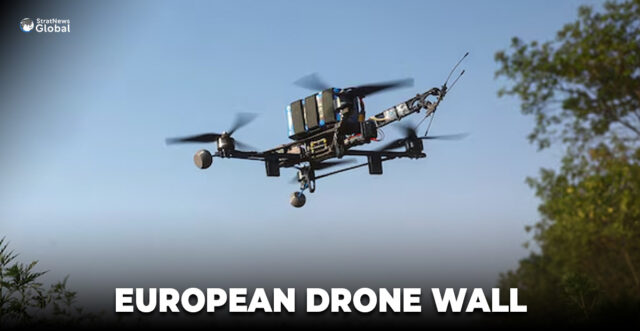Hours after around 20 Russian drones breached Polish airspace last month, European Commission President Ursula von der Leyen called for a “drone wall” to defend Europe’s eastern flank.
Drone incidents over airports in Denmark and Germany in the following weeks reinforced European leaders’ view that the continent urgently needs better protection against such threats.
But the “drone wall” proposal remains in flux, according to more than half a dozen officials and diplomats familiar with internal EU deliberations who spoke to Reuters about the project.
“Our capabilities are really, for the time being, quite limited,” said European Defence Commissioner Andrius Kubilius, who is playing a leading role in fleshing out the proposal.
Kubilius told Reuters the EU would need to draw heavily on Ukrainian expertise, honed over nearly four years countering waves of Russian drones.
Defence Test
The drone project is a test of the EU’s ambitions to play a greater role in defence – traditionally the preserve of national governments and NATO – as well as Europe’s ability to take more responsibility for its own security, as demanded by U.S. President Donald Trump.
The Commission, the EU’s executive body, has been trying to win over southern and western European governments, which argued the original idea was too focused on the bloc’s eastern border when drones could pose a threat across the whole continent.
The proposal is also caught up in a power struggle over who should control major European defence projects, with Germany and France wary of handing power to the Commission, diplomats say.
Some EU officials questioned the name “drone wall”, arguing it implies a false promise of security when no system will be able to repel every drone.
To try to win more support, the Commission has broadened the original concept – from an integrated thicket of sensors, jamming systems and weapons along the eastern border to a continent-wide web of anti-drone systems.
As first reported by Reuters on Tuesday, the Commission plans to switch to the term “European Drone Defence Initiative” in a defence policy “roadmap” to be unveiled on Thursday.
If it goes ahead, the project would be a bonanza for makers of anti-drone systems – from startups in the Baltic states to bigger defence industry players such as Germany’s Helsing and Rheinmetall.
The Commission has not said how much the proposal would cost, but geopolitical consultancy RANE said it could generate billions of euros in orders.
But without broad support from European governments, the plan will struggle to secure access to EU funding, experts said.
“The path to realisation remains long and fraught with constraints,” said Matteo Ilardo, RANE’s lead Europe analyst, pointing to big challenges “in terms of cost, scale and cross-border integration”.
Jets Vs Drones
Baltic countries, along with Poland and Finland, pitched the idea of a “drone wall” to the European Commission last year, a spokesperson for Estonia’s border guard told Reuters.
The countries applied for funding from an EU civilian border management fund, with the aim of deploying sensors and drones to combat people smuggling, the spokesperson said.
The project initially failed to gain traction at the EU level.
But the idea evolved into a more defence-focused concept after Ukrainian Deputy Prime Minister Mykhailo Fedorov gave a presentation to von der Leyen in April in Brussels on how Ukraine counters Russian drone attacks, EU officials said.
The Russian incursion into Polish airspace on September 9 highlighted how ill-prepared EU countries currently are to tackle the threat posed by swarms of drones, adding to the sense of urgency.
NATO deployed F-35 and F-16 fighter jets, helicopters and a Patriot air defence system collectively worth billions of dollars to respond to Russian Gerbera drones – based on Iranian Shahed models – that cost a tiny fraction of the price.
“A 10,000-euro drone shot down with a million-euro missile – that’s not sustainable,” Kubilius told a defence conference in Brussels on Tuesday.
French, German Scepticism
Once the Commission has fleshed out its proposal, EU governments will decide whether to give it the green light.
Diplomats say smaller countries see more value in having the Commission as a coordinator on such projects. But big countries such as France and Germany, which are used to handling large procurement initiatives themselves, want to retain control.
Neither German Chancellor Friedrich Merz nor French President Emmanuel Macron has so far embraced the proposal.
At an EU summit in Copenhagen earlier this month, Macron said the threat of drones was “more sophisticated, more complex” than the idea of a drone wall suggested.
Countries wanting to cooperate on an anti-drone system can use national budgets and the EU’s 150 billion euro SAFE loans scheme for defence projects. But if the EU gives the project the status of a European Defence Project of Common Interest, countries involved would have access to a broader range of EU funding.
The EU would also have to agree on who would run the project – member countries, the Commission, another EU body or some combination of all of those.
(With inputs from Reuters)





